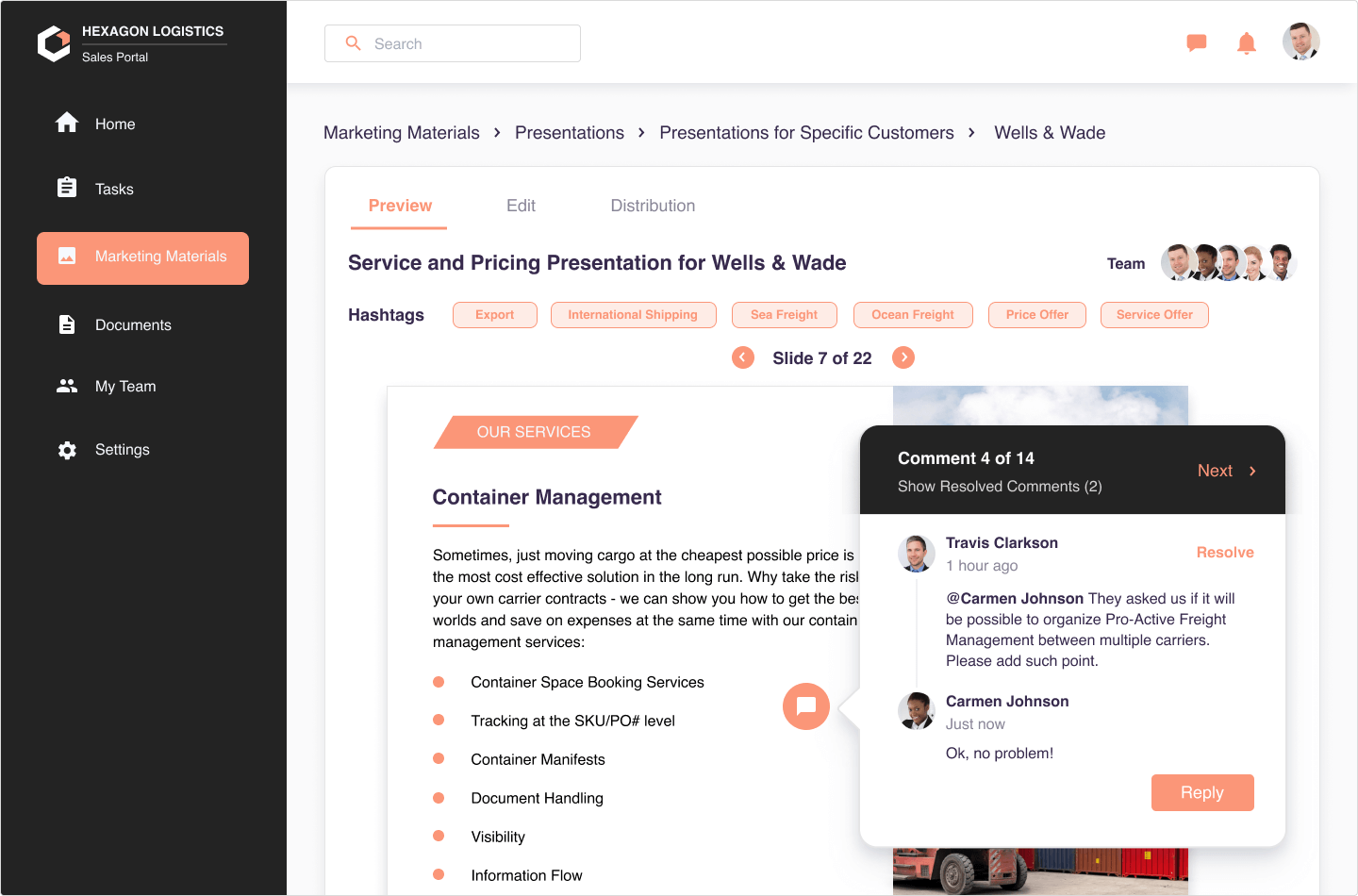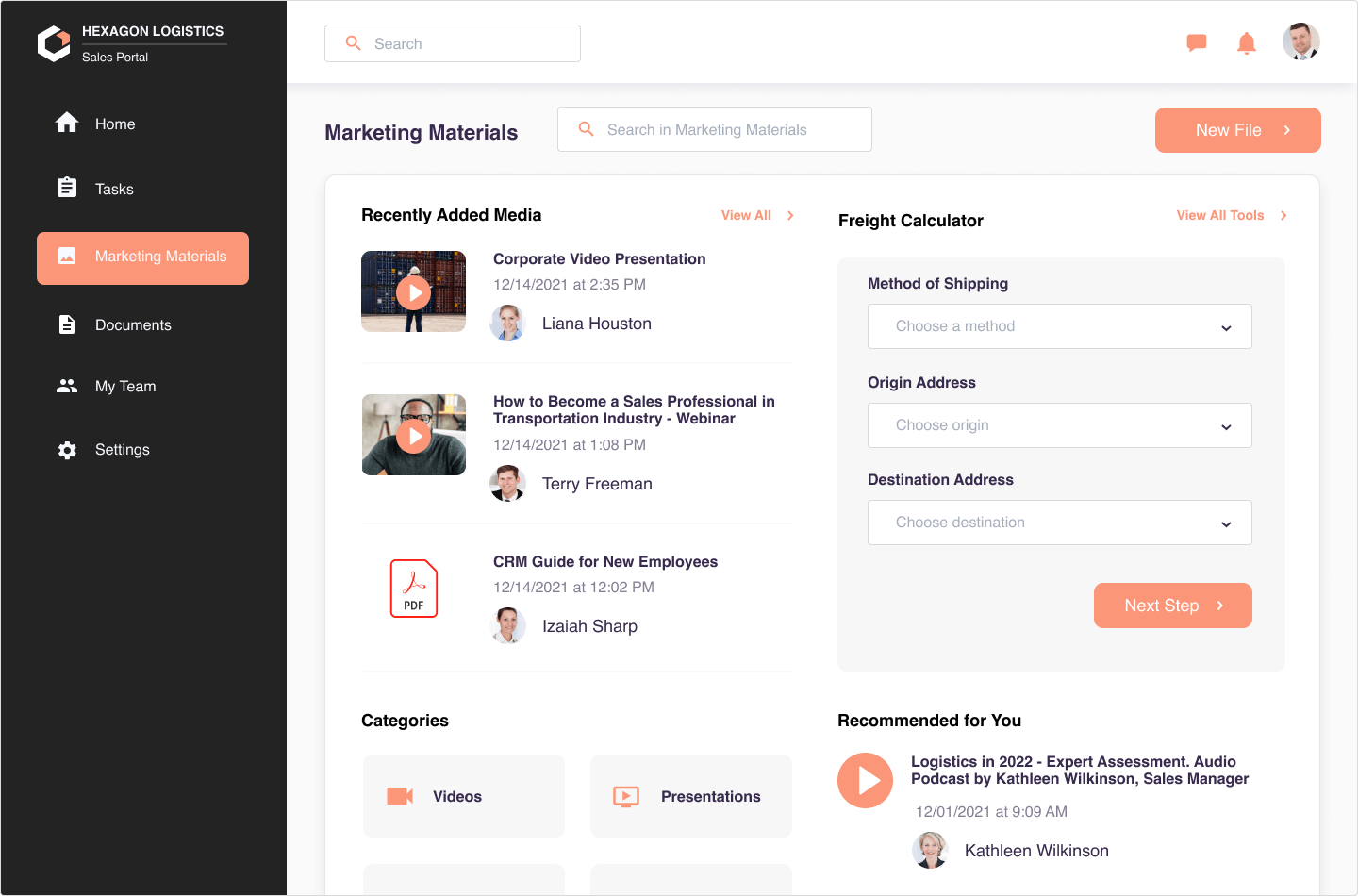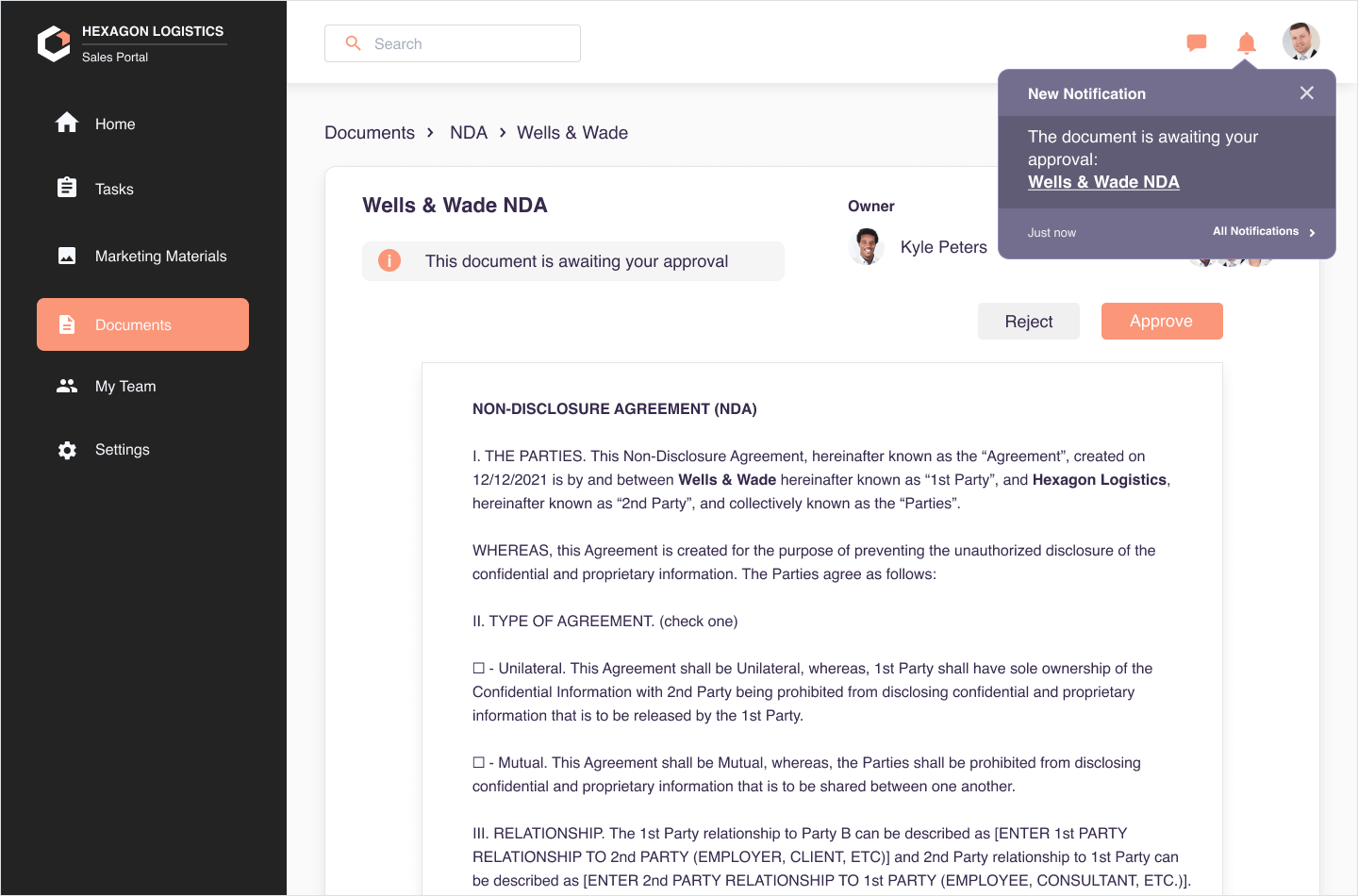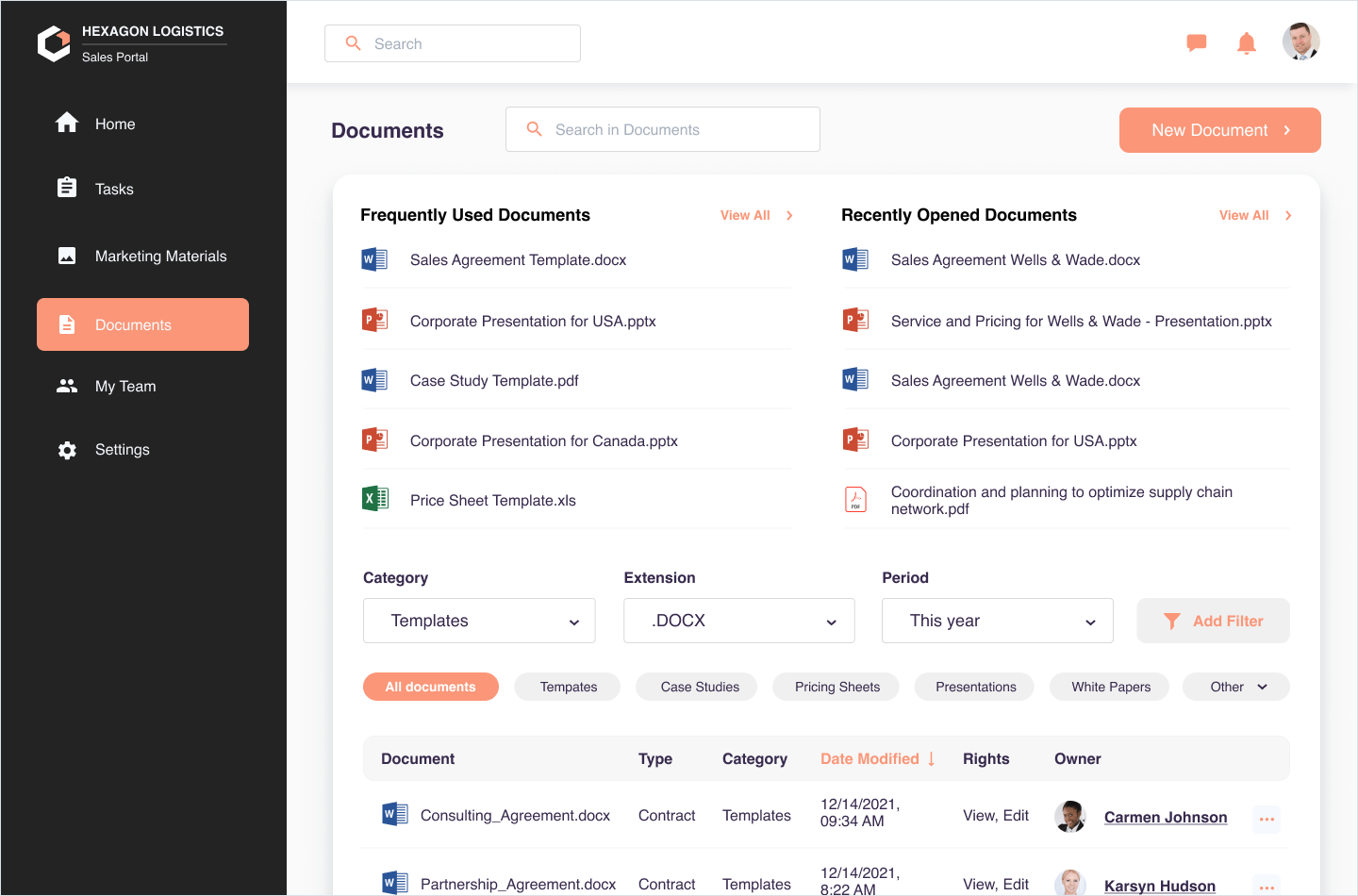Sales Portals
ScienceSoft Talks about Effective Sales Enablement
Since 2005, ScienceSoft has been designing and developing web portals for different business goals and audiences: sales teams, employees, customers, vendors, and business partners.
Sales Portal: the Essence
A sales portal is a digital workspace where sales teams create, store and share marketing and sales content. Thus, a sales portal must be easily searchable, convenient for document collaboration and co-authoring, secure and up-to-date.
Depending on your business model, you may have a sales portal for your internal sales reps only or an online sales portal for your business partners (distributors) who sell to end customers. A long-run goal of sales portal implementation is an increase in signed deals and overall sales, owing to:
- Quick and timely access to corporate materials supporting communication with prospects or leads: case studies, client testimonials, white papers, and more.
- Product knowledge transfer to your distributors.
- A possibility to work with sales and marketing collateral on the go (e.g., from on-site events like conferences and trade shows).
- A unified sales approach established based on best practices and reflected in commonly available guidelines and rules.
- No risk of several document versions stored by different sales reps and spread of incorrect information to prospects and leads.
Explore Functional Capabilities
ScienceSoft works with different types of web portals and each has its own characteristics. When talking about a sales portal, we see it as a tool in a sales kit that facilitates and improves sales processes. Thus, it must be:
Collaborative
Many teams may participate in the creation and distribution of the materials stored within a sales portal: sales and marketing departments, designers, project managers, to name a few. A portal enables comfortable collaboration in the common space due to:
- Document co-editing.
- Document version control: visibility into all the changes made, a possibility to restore the doc to previous versions.
- Document approval workflow: approval requests to responsible team members and notifications on approval status.
- Team workspaces to collaborate on content, get involved into team discussions, leave comments.
- A possibility to manually share the materials.
Easily searchable
Often, sales people have hours, not days, to create comprehensive product/service presentation and showcase the company’s strengths to make their communication with prospects and leads persuasive. It helps when they can find sales enablement materials quickly due to:
- Catalog-like document storage with categories and subcategories.
- Filters and tags to quickly and automatically select materials targeting leads from different countries/regions, industries, with different product/service requests.
- A search box to type search requests.
- A possibility to add frequently used materials to favorites.
- AI-powered content recommendations.
- Personalized search based on chosen factors: user’s search history, location, target customer segment.
Informative
Rich content management capabilities are essential for sales portals as sales and marketing materials can be created and stored in the formats of:
- PDF: project descriptions, user guides, white papers.
- PowerPoint: sales presentations.
- Video: team presentation, demos.
- Live video streaming: product trainings for sales reps and external partners, webinars.
- MS Word: different templates like for emails or case studies.
- Excel: pricing sheets.
- Interactive tools: cost calculators, product configurators.
- Recorded voice messages.
Up-to-date
Monitoring the up-to-dateness of vast information resources manually is challenging and time-consuming. A sales portal facilitates the task with:
- Indication of document creation date and follow-up updates.
- A possibility to tag a responsible employee and initiate document update if needed.
- Notifications to sales people (the whole team or selected employees) on the release of new or updated materials.
Secure
You ensure the security and confidentiality of your sales materials by setting up:
- Differentiated access to certain resources for internal or external users.
- Hierarchy of permissions for access, editing and deleting docs.
- Custom permissions.
Learn What Integrations Are Needed
ScienceSoft recommends the following integration plan to make sales portal software a part of a larger sales process and ensure convenient collaboration of multiple teams on collateral creation and distribution.
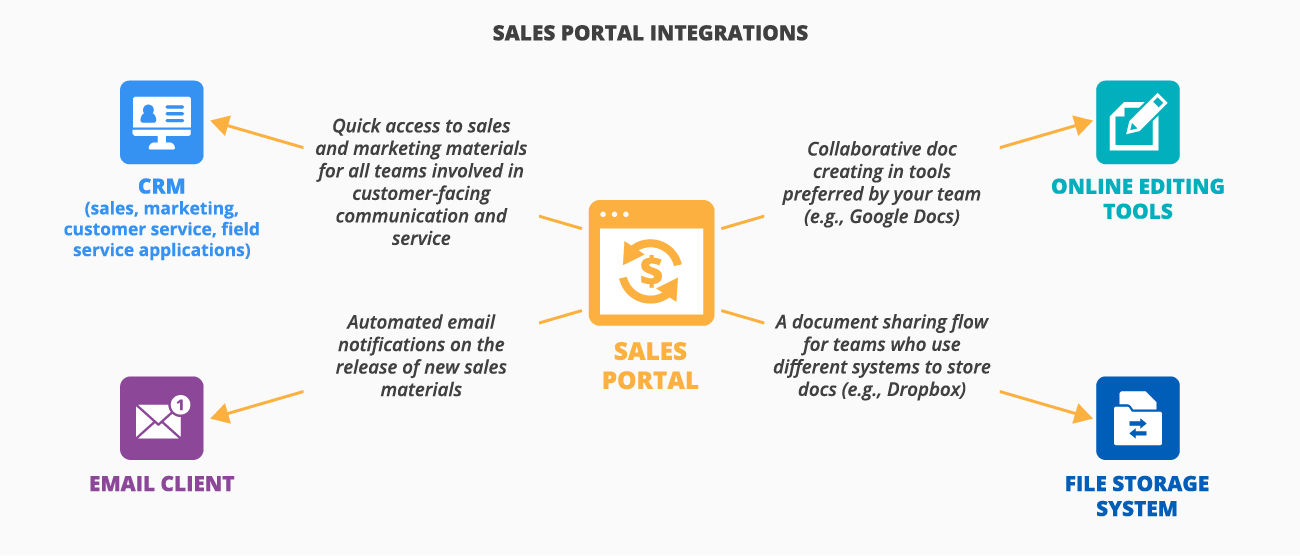
Increase the Usability of Your Sales Portal
Usability is just as important for sales portals as for any other business applications. It largely determines if this tool will be useful for a team in day-to-day work and impact the sales performance as planned. We asked senior web developers from ScienceSoft and can share with you the two most important practices they use to ensure high portal usability.
Conducting UX research of end users
(In focus groups and one-to-one sessions). There may be a need to group your internal and external sales people separately. The goal is to understand the main bottlenecks in the process that you want to optimize, namely, the collaborative creation of sales and marketing materials as well as the search and spread of these materials to support sales communication. Among the most frequent problems is misalignment between sales and marketing: a sales team is often unaware of created marketing materials and thus don’t use them. UX research will help you look deeper than this general problem and spot smaller, yet significant, details: for example, search criteria sales people use now will be applied as filters in a sales portal.
Testing the portal’s usability with a representative group of end users
(Your internal and external sales people, perhaps also a marketing team). During the usability testing, you actually test your hypothesis regarding user experience and observe the behavior and reactions of real users. To conduct usability testing, you need to elaborate test scenarios that reflect the most common activities of your teams, for example task users to find testimonials from large business clients (1,000 employees and more) but set bounds on the geographical region, industry and date of submitted testimonials.
Build a Sales Portal
The best platform we choose for sales portal development
Power Apps
Description
- Provides a drag-and-drop development interface with business workflow components and connects to multiple data sources.
- Doesn’t require coding skills to create and manage business apps.
- Still, doesn’t restrict code customization either, which helps create less common business rules and workflows.
- Can reduce portal development costs by up to 74%.
- Promises an average of 188% ROI within three years after app deployment.
Market position:
- Leader among low-code application platforms recognized by such technology advisors as Forrester and Gartner.
- Companies using Power Apps to build business applications range from startups to market leaders like Toyota, Ikea and Hexion.
Best for
Rapid portal development and fast time-to-value
Pricing
Microservices we choose for custom sales portal development
Custom development of a sales portal
Description
- A sales portal can be built as a set of microservices, each responsible for a separate function.
- A modular architecture of such a solution is perfect for iterative development.
- Allows for full flexibility in functionality and user interface design.
- Is easier to maintain down the road than a heavily customized platform-based solution.
Best for
Specific business situations (e.g., differentiated experience for internal and external users)
Pricing
Estimate Your Investment and ROI

The average cost of sales portal development varies between $70,000 and $150,000. Investing this much, you will be able to create a repository for your sales and marketing materials existing in different formats and configure the required search capabilities.
Want to estimate the cost of your future sales portal?
The main value that a sales portal creates is an opportunity to earn trust of prospects and leads, and with that increase sales velocity. Each of the factors below can be seen as contributing to general ROI:
|
|
Reduced time for response to leads to get ahead of competitors. |
|
|
Persuasive selling supported by the evidence of the required experience: case studies, client testimonials, relevant certifications, etc. |
|
|
Advanced product/service knowledge built with white papers, presentations and other informative resources, and owned by your sales team. |
ScienceSoft Answers Frequent Questions
How long does it take to create a sales portal?
Project duration surely depends on your business requirements but commonly it takes 3–6 months to build a sales portal.
What is the difference between a sales portal and CRM?
The key difference between a sales portal and CRM is the type of information these systems store. A sales portal is intended for sales and marketing materials: presentations, client testimonials, proposals, etc. CRM stores customer-related information: customers’ personal details and the history of their interaction with a company (communication, orders).
Should you build your own sales portal, or should you buy a dedicated sales portal software?
You can go with ready-to-use sales portal software if it largely meets your business requirements. But you should understand that such software usually has customization limitations that can block the modification of its functionality. A custom sales portal is a better choice if you want an extensible solution fully tailored to your business-specific processes.
Implement a Sales Portal with ScienceSoft
At ScienceSoft, we offer all-round support for sales portal development. We take responsibility for:
|
|

About ScienceSoft
Since 2008, our team is interested in technologies and approaches that assist businesses in complex sales: automate tedious processes, centralize information on leads and customers, raise the efficiency and motivation of sales teams. Feel free to ask for expert help if you want to reorganize and improve sales processes in your organization.
